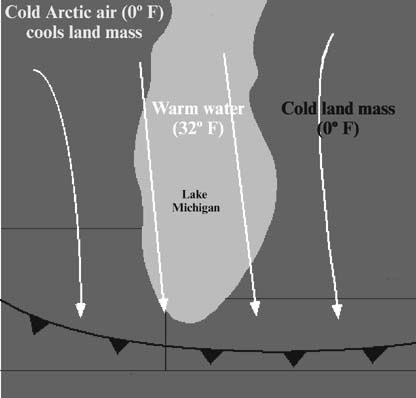The University Record, December 10, 1997
By Adam Marcus
College of Engineering
|
|
|
The Great Lakes appear to have a significant impact on the weather over much of the eastern United States and Canada but scientists are not certain why. Peter J. Sousounis will be joined by colleagues from 20 universities this month and next to conduct Lake-ICE (Lake-Induced Convection Experiment) to try to determine the how and why of the lakes’ effect on weather. |
As many as 50 scientists from 20 universities will converge on the University this month for the most ambitious investigation of Midwest meteorology ever undertaken.
The Lake-Induced Convection Experiment (Lake-ICE) will use airplane-borne sensing devices and ground-based stations to determine how arctic air masses are affected by the Great Lakes in winter and how the heat and moisture from the Lakes generate circulations on the cloud scale, the lake-effect scale, and the lake-aggregate scale.
Peter J. Sousounis, who is one of the principal investigators and a key planner for the multi-million dollar, two-month study, says that while the Great Lakes appear to have a significant impact on the weather over much of the eastern United States and Canada–extending well across the eastern seaboard–the mechanisms of its action aren’t well understood.
Small-scale “lake-effect” snowstorms can dump massive amounts of precipitation on the region in blindingly fast time, but no one really understands exactly how or why. Larger scale heating effects from the Great Lakes aggregate can further alter the characteristics of these lake-effect storms‹determining who sees sun and who sees blizzard conditions. Understanding how cold air is modified over the Great Lakes will help meteorologists worldwide better understand how cold air is modified over other warm water bodies.
One likely key to understanding the large-scale effects is a whorl of air that develops from tremendous heating and moistening by the lakes during wintertime cold air invasions over the United States and southern Ontario–which Sousounis has dubbed a mesoscale aggregate vortex. “It’s a brand new weather phenomenon that’s only recently been discovered,” says Sousounis, assistant professor of atmospheric, oceanic and space sciences.
Sousounis already has modeled the 1,000 km-wide vortex using a computer, and found that, in simulations ignoring the Great Lakes, weather patterns in the region don’t look anything like what we really see. With the lakes, however, the combined effect of the vortex and the water–which acts as a heat source for the surrounding air‹creates powerful “lake-effect” snow storms and far-reaching weather disturbances, which we do see. “We’re just now beginning to understand the far-reaching effects that the Great Lakes have on weather and climate,” Sousounis says.
Beginning this month, Sousounis and his colleagues, including scientists from the University of Illinois, Penn State University, the University of Washington and the National Center for Atmospheric Research, to name a few, will begin gathering data from specially-equipped airplanes that will fly over Lake Michigan. Dozens of land-based detectors also will be employed over the Great Lakes region, taking measurements of upper-level wind speed and direction, temperature, humidity and other so-called “basic parameters.”
All of these data should allow Sousounis and his colleagues to see for the first time what his model has been generating for years, as well as to understand more thoroughly how the Great Lakes affect weather patterns, including the vortex, over the Great Lakes region.
The information will be useful for the National Weather Service, which also is participating in Lake-ICE, and should help forecasters better incorporate the effects of the lakes into their weather predictions.


